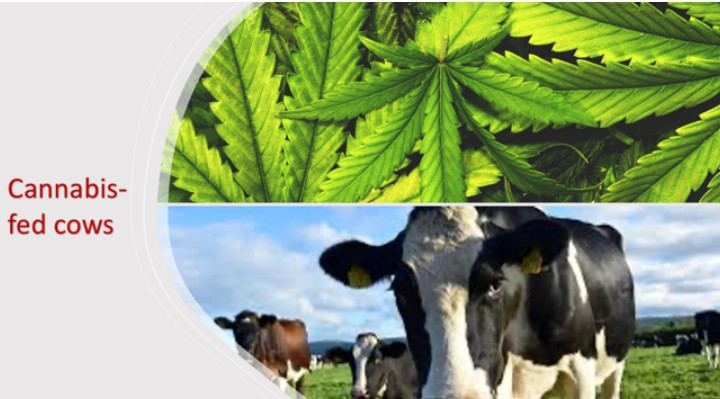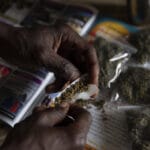The hemp plant is of same species as marijuana. They both belong to the genus, Cannabis, and are commonly referred to as Cannabis sativa. While hemp contains high concentrations of cannabidiol or CBD and less of tetrahydrocannabinol or THC, marijuana is high in THC and less in CBD. The major difference between the two chemicals is that THC is very psychoactive than CBD. In other words, THC gives one that “high” feeling and CBD less so.
The hemp is a fast-growing plant used in various applications including, medicines, ropes, biodegradable plastics, biofuel, textiles, paper, insulation, paint, food and most importantly as animal feed. It is the use of hemp as animal feed that is raising eyebrows. This is due to the suspicion that some cannabinoids in the feed might pose a risk to consumers by getting them high on animal products like milk and meats.
Join our WhatsApp ChannelThe endocannabinoid system regulates and controls many important functions in the body including, learning and memory, emotional processing, sleep, temperature control, pain control, inflammatory and immune responses, and eating. In fact, the brain has tiny cannabis-like molecules floating around in it. Cannabinoids in turn regulate the endocannabinoid system in both animals and humans.
Wagner and coworkers writing in the November 2022 issue of the journal, Nature Foods, presented the results of their feeding experiment in which they fed lactating dairy cows with industrial hemp silage.
The researchers from the German Federal Institute for Risk Assessment initially replaced the normal feed of corn silage with whole plant hemp, having very low cannabinoid concentration. After the cows adapted to this diet, they were then introduced with a feed of hemp silage made from leaves, flowers, and seeds of the hemp plant. This contains higher cannabinoid concentration. The initial feed with the low cannabinoid concentration was 0.84 kg dry matter per cow per day, while the feed with the higher cannabinoid concentration was 1.68 kg dry matter per cow per day, i.e., doubling the initial feed.
While the feed intake and milk production were decreased in the cows when fed with high cannabinoid concentrated hemp silage, no such impact on the physiological condition was observed when the cows were adapting to the low cannabinoid concentrated hemp feed. But the animals, as the feeding progressed, were completely stoned. Their appearance and behaviour were classical symptoms of dopiness. The addled cows showed “pronounced tongue play, increased yawning, salivation, nasal secretion formation, prolapse (unsteady walk), reddening of the nictitating membrane (eye redness), somnolent appearance, unusually long standing and abnormal posture, breathing and heart rates were slowed.” These symptoms disappeared within two days of discontinuing cannabinoid feeding. The cows required about 86 times more of THC (i.e. tetrahydrocannabinol) consumption during their feeding than humans for the dopey effect described above to occur.
The alarming discovery is that various cannabinoids from the hemp feed were detected in the milk. This is consistent with the common knowledge that cannabidiol (CBD) and tetrahydrocannabinol (THC) are transferred into breast milk after marijuana use. However, just like the disappearance of the stoned symptoms after discontinuing cannabinoid feeding, so did the cannabinoids levels in milk also declined (i.e. after discontinuation of cannabinoid feeding).
The findings in this report are of importance to state regulators trying to make decisions about the safety issues involved in replacing animal feeds with the cheap and fast-growing hemp plants. The issue of the active ingredient in marijuana (i.e. cannabinoid), entering the human food supply through the milk of doped up cows should be of concern to public health and safety.
In a separate study, it has been observed that cows fed with smaller quantities of hemp had lower stress levels and they tend to lie down more often. This means that in stressful situations as obtained when transporting or weaning cows, replacing the normal feed with hemp might be a good idea to calm cows and reduce weaning distress.
So, if you should see any cow perambulating about and describing an arc, have pity on the poor thing, it might have been doped! And the good news is that cannabidiol (CBD) is an important chemical for relieving cases of addiction, anxiety, and insomnia, amongst other health uses. Therefore, milk from doped cows should be potential money-making merchandise.
And certainly, one would not be entering into the realm of fantasy to posit that very soon, milk cans and boxes might start carrying a warning sign like cigarette packages, “Caution: This milk is produced from a cannabis-fed cow and may get you high.”
READ ALSO: New Remedy For Parkinson’s Disease



![Relishing Ugba [Oil Bean] Delicacy](https://www.primebusiness.africa/wp-content/uploads/2025/06/Ugba-delicacy-720x480.jpg)














Follow Us